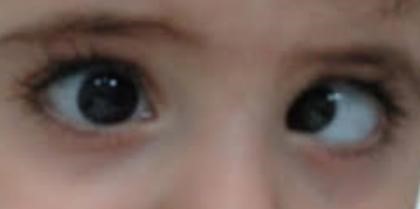- Non accommodative esotropia or non accommodative convergent squint refers to the eso deviations which are not primarily elicited by the direct influence of accommodation.
- Developed after the age of 6 months and not associated with the accommodative component.
- Deviation at near = distance.
- Correcting any Hyperopia or prescribing near addition will give no effect on the size of exotropia.
¤ TYPES OF ESODEVIATION:—
- Incomitant
- Paralytic
- Neurogenic (e.g abducens palsy, divergence palsy)
- Myogenic (e.g myasthenia)
- Restrictive
- Masculofascial (Duan’s)
- Other Restrictive conditions (e.g tumor, postoperative, dysthyroid)
- Spastic
- Concomitant
A- Accommodative
- Refractive (hypermetropic)
- Non-refractive (hyper accommodative)
B – Partially accommodative
- Non-accommodative
NON ACCOMMODATIVE ESOTROPIA:
ESSENTIAL INFANTILE ESOTROPIA , ESSENTIAL ACQUIRED ESOTROPIA
– Convergence excess
– Divergence Insufficiency
– Basic
ACUTE ACQUIRED COMITANT ESOTROPIA
- Acute Strabismus after artificial interruption of fusion. Acute Strabismus without preceding disruption of fusionAcute Esotropia of neurological origin
- CYCLIC ESOTROPIA RECURRENT ESOTROPIA
- ESSENTIAL INFANTILE ESOTROPIA :
— Common Comitant Esotropia occurs before 6 months of age.
— Deviation is often large more than 40 prism dioptre.
— Frequently associated with Nystagmus and inferior oblique overcorrection.
— Not improved with hyperopic Rx.

ETIOLOGY :
》 Idiopathic
》 family history of Strabismus
》born prematurely
》primary motor dysfunction associated with poor fusion.
CLINICAL FEATURES :
○ onset after birth to 6 months.
○ cross Fixation
○ Refractive error may or may not be present.
○ Visual acuity is normal or equal in both eyes.
TREATMENT :
- Muscle surgery
- Bilateral MR Recession or LR Resection.
B. ESSENTIAL ACQUIRED ESOTROPIA :
○ Convergence excess Esotropia:—
– Comitant Esotropia.
– more deviation at near than distance.
– divergence is normal.
– Not associated with any refractive error or high Ac/A ratio.

ETIOLOGY :
》 Increased innervational tone of Converging muscles.
CLINICAL FEATURES :
- Onset 1-5 yrs of age.
- Ac/A ratio is normal.
- NPA is normal.
- The amount of deviation is near than distance.
- Refractive error may be hypermetropic or else Emmetropic.
TREATMENT :
- Muscle surgery ( BL MR recession but depends on the surgeon.
○ Divergence Insufficiency Esotropia:—
- The deviation is more in distance than near.
- Convergence for near is normal.
- Associated with the weakening of the diverging muscle.
- Chances o Amblyopia is high.
ETIOLOGY :
》 innervational imbalance in Muscle action.
CLINICAL FEATURES :
- After 6 months of any age.
- Ac/A is normal.
- NPA is normal.
- The amount of deviation is more at distance than near.
- Refractive error is not associated.
TREATMENT :
- Spectacles with BO prism are helpful.
- A spectacle to be worn when distance vision is needed.
○ Basic:— Amount of deviation is almost equal for distance and near in the optically corrected eye.
- Normal Ac/A ratio.
- Comitant Esotropia.
ETIOLOGY :
》innervational imbalance in Muscle.
》onset after 6 months-5 yrs.
》NPA within normal limit.
》Refractive error = Hyperopia or Emmetropia.
TREATMENT :
- Treat Amblyopia first.
- Muscle surgery ( BL MR RECESSION).
- No glass or Miotics are helpful.
C. ACUTE ACQUIRED COMITANT ESOTROPIA:
○ Acute Strabismus after artificial interruption of fusion:—
- pt. May have no history of squint.
- Esotropia occurs after the interruption of fusion.

CLINICAL FEATURES :
○ associated with precipitating factors— refractive error or systematic illness.
○ Diplopia
○ amount of deviation is slightly more near than distance.
○ onset is Acute, Can occur in any age group.
TREATMENT :
- Muscle surgery: BL MR recession or BL MR resection.
- Refractive error or systematic illness management.
○ Acute Strabismus without preceding disruption of fusion:—
- Diplopia
- Acute onset
- Refractive large angle of esotropia
- No interruption of fusion is associated.
CLINICAL FEATURES :
○ Onset is Acute for all age groups.
○ The amount of deviation is 20-60 prism.
○ Accommodation
ETIOLOGY :
》Idiopathic
TREATMENT :
- Muscle surgery- BL MR Recession or BL MR resection
- Refractive error or systemic illness management.
○ Acute Esotropia of neurological origin:—
- It is always associated with Neurogenic problems like brain tumors, hydrocephalus, etc.
CLINICAL FEATURES :
○ Onset is Acute.
○ Neurologic origin
○ Refractive error influence is minimal.
TREATMENT :
- Refer to a neurologist. Not go for surgery.
- CYCLIC ESOTROPIA- A Strabismic or no Strabismic phase of 24 hrs. Each.
- A cycle may last from 4 months to several years.
- 48 hours of cycle is most common however 72 and 96 of cycle are also reported.
CLINICAL FEATURES :
○ onset early infancy to early childhood.
○ Amount of deviation for both near and distance ranges from 40-70 prism.
○ fusional amplitude is defective or absent.
○ fusion and stereopsis are normal.
○ suppression in one eye.
ETIOLOGY:
》Idiopathic
TREATMENT:
- Muscle surgery.

- RECURRENT ESOTROPIA :
- An unusual form of esotropia. Recurrence of the same angle even after multiple surgeries. Not associated with any conditions like Nystagmus blockage syndrome, blind spot syndrome, increased uncorrected esotropia, etc.
CLINICAL FEATURES :
○ normal Ac/A.
○ recurrent occurrence.
○ refractive error influence is minimal.
ETIOLOGY :
》Idiopathic
TREATMENT :
- Muscle surgery
- BI Prisms mounted on spectacle.










